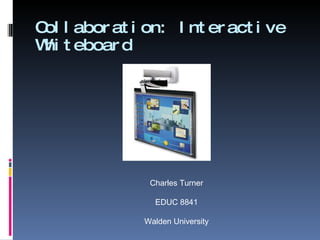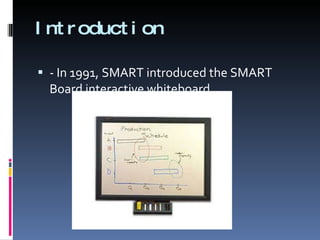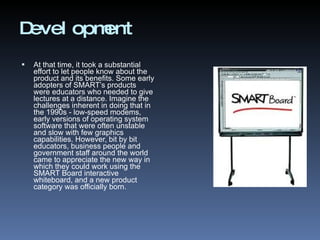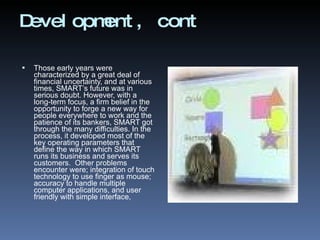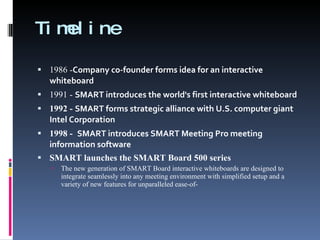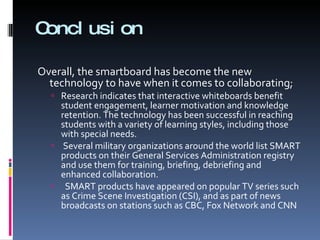Chalkboard to smartboard
- 1. Collaboration: Interactive Whiteboard Charles Turner EDUC 8841 Walden University
- 2. Introduction - In 1991, SMART introduced the SMART Board interactive whiteboard.
- 3. What is a Smartboard? The SMART Board interactive whiteboard was the first interactive whiteboard to provide touch control of computer applications and annotation over standard Microsoft Windows applications. The SMART Board interactive whiteboard, connected to an LCD panel and a computer, introduced the world to interactive technology in classrooms, meeting rooms and boardrooms.
- 4. Need Ability to collaborate in real-time, in an electronically shared space. Co-Founder, Dave Martin presents the idea to Nancy , to create an interactive whiteboard that will allow collaboration in real-time, and in an electronically shared space. This collaboration could be in any environment; education, business, or government.
- 5. Research Nancy Knowlton, CEO and Co-founder, along with her husband David Martin, developed the whiteboard, a computer and projector combined. In those early years no one knew about interactive whiteboards, much less why they might want or need one, so sales for SMART started slowly.
- 6. Development At that time, it took a substantial effort to let people know about the product and its benefits. Some early adopters of SMART’s products were educators who needed to give lectures at a distance. Imagine the challenges inherent in doing that in the 1990s - low-speed modems, early versions of operating system software that were often unstable and slow with few graphics capabilities. However, bit by bit educators, business people and government staff around the world came to appreciate the new way in which they could work using the SMART Board interactive whiteboard, and a new product category was officially born.
- 7. Development, cont Those early years were characterized by a great deal of financial uncertainty, and at various times, SMART’s future was in serious doubt. However, with a long-term focus, a firm belief in the opportunity to forge a new way for people everywhere to work and the patience of its bankers, SMART got through the many difficulties. In the process, it developed most of the key operating parameters that define the way in which SMART runs its business and serves its customers. Other problems encounter were; integration of touch technology to use finger as mouse; accuracy to handle multiple computer applications, and user friendly with simple interface,
- 8. Commercialization In 1992 SMART formed a strategic alliance with U.S. computer giant Intel Corporation. This alliance resulted in joint product development, joint marketing efforts and Intel's equity ownership in SMART. While the initial project that caused the investment to be made has long since been completed, the equity ownership in SMART remains. Other than the Intel equity investment and some small investments from family and friends, the company relied on its retained earnings to fuel growth in the early years.
- 9. Timeline 1986 - Company co-founder forms idea for an interactive whiteboard 1991 - SMART introduces the world's first interactive whiteboard 1992 - SMART forms strategic alliance with U.S. computer giant Intel Corporation 1998 - SMART introduces SMART Meeting Pro meeting information software SMART launches the SMART Board 500 series The new generation of SMART Board interactive whiteboards are designed to integrate seamlessly into any meeting environment with simplified setup and a variety of new features for unparalleled ease-of-
- 10. Timeline cont. 1999 - SMART introduces SynchronEyes software SynchronEyes classroom instruction and computer-control software allows teachers to monitor and control student computers in a networked classroom. 2000 - SMART launches Research Assistance Program This program supports research on technology that supports group collaboration and whole-class teaching and learning. MoreLess SMART opens offices in Bonn, Germany, Tokyo, Japan and Washington, DC SMART continues to expand operations worldwide and localize support for distributors
- 11. Timeline cont. 2003 - SMART introduces Bridgit data conferencing software Bridgit multiuser software allows meeting attendees to easily connect and share screen information over distances. SMART invents breakthrough touch technology SMART introduces DViT (Digital Vision Touch) technology, a breakthrough technology that enhances the functionality of SMART Board interactive whiteboards. 2004 - SMART Board for Flat-Panel Displays plays integral role in Mars mission The product has been incorporated with NASA's plasma displays to create a network of MERBoards, or a large, touch-enabled, plasma display system with custom MERBoard software 2005 - SMART introduces SMART Notebook software
- 12. Timeline, cont. 2006 - SMART launches new Sympodium produ cts SMART introduces the Sympodium ID350 and ID370 interactive pen displays. SMART named one of Canada’s 50 Best Managed Companies for 8th consecutive year First named one of Canada’s 50 Best Managed Companies in 1996, SMART achieved Platinum Club status in 2004. This latest award marks the 8th consecutive year the company has been awarded the 50 Best distinction. 2007 - SMART launches Senteo student response system SMART introduces SMART Notebook interactive viewer 2008 - SMART introduces first interactive table developed for primary education 2009 - SMART products link inauguration of Barack Obama to Chicago supporters
- 13. S-Curve Some early adopters of SMART’s products were educators who needed to give lectures at a distance. Imagine the challenges inherent in doing that in the 1990s - low-speed modems, early versions of operating system software that were often unstable and slow with few graphics capabilities. However, bit by bit educators, business people and government staff around the world came to appreciate the new way in which they could work using the SMART Board interactive whiteboard, and a new product category was officially born.
- 14. Perceived Attributes Some early adopters of SMART’s products were educators who needed to give lectures at a distance. These innovators and early adapters were persuaded by the benefits of the interactive whiteboard. The laggards of this innovation would be those individuals who are not technology savvy, those teachers who are stuck in the “one size fit all” mentality. Providing training and professional development would help ease the apprehension of using this innovation.
- 15. Decentralization/Centralization A decentralization approach to this innovation would work best in my field of study. Having someone or several people who are trained to operate the technology can provide the one-on-one training or training in small groups to help others get acquainted with the technology. Those individuals who were trained would become the key change agents for the adoption of the technology.
- 16. Society This innovation has met the critical mass in society; - Over 1.6 million SMART Board interactive whiteboards have been installed throughout the world in education, business, government and military settings
- 17. Conclusion Overall, the smartboard has become the new technology to have when it comes to collaborating; Research indicates that interactive whiteboards benefit student engagement, learner motivation and knowledge retention. The technology has been successful in reaching students with a variety of learning styles, including those with special needs.   Several military organizations around the world list SMART products on their General Services Administration registry and use them for training, briefing, debriefing and enhanced collaboration.   SMART products have appeared on popular TV series such as Crime Scene Investigation (CSI), and as part of news broadcasts on stations such as CBC, Fox Network and CNN
- 18. References SMART Technologies. Retrieved August 21, 2010, from http://www.smarttech.com.
